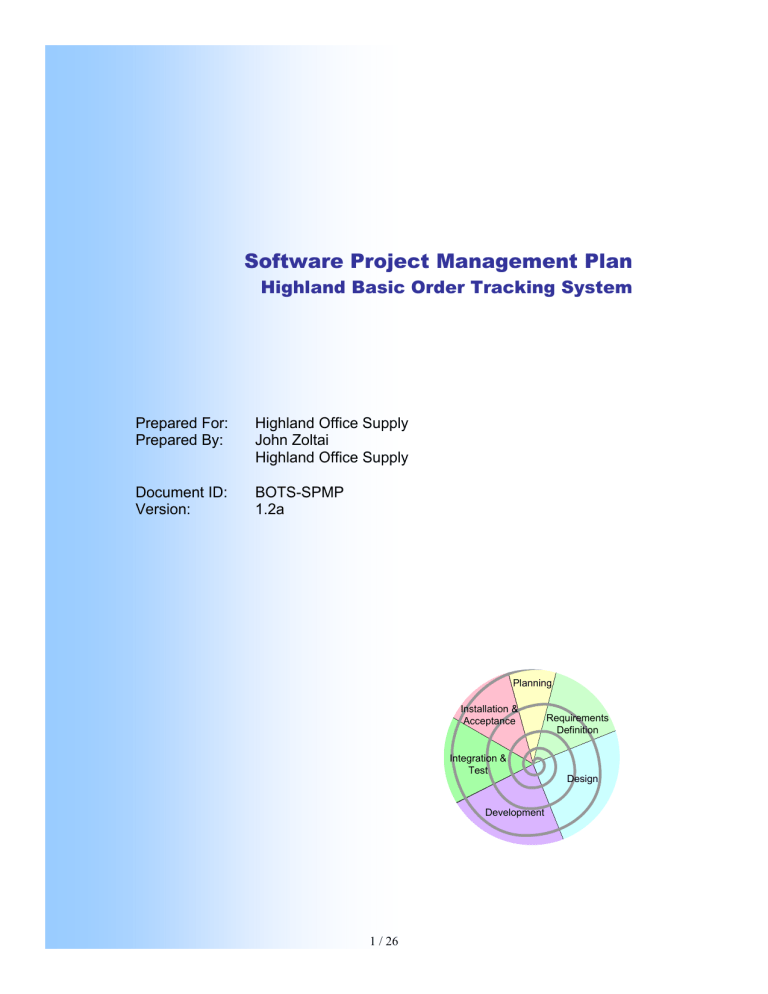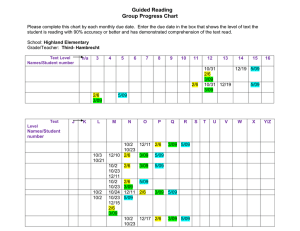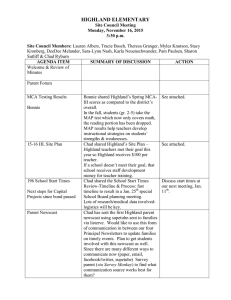
Software Project Management Plan
Highland Basic Order Tracking System
Prepared For:
Prepared By:
Highland Office Supply
John Zoltai
Highland Office Supply
Document ID:
Version:
BOTS-SPMP
1.2a
Planning
Installation &
Acceptance
Integration &
Test
Development
1 / 26
Requirements
Definition
Design
Software Project Management Plan
Highland Basic Order Tracking System
BOTS-SPMP v1.2a
Copyright © 2005 Highland Office Supply.
All Rights Reserved.
2
Software Project Management Plan
Highland Basic Order Tracking System
BOTS-SPMP v1.2a
TABLE OF CONTENTS
INTRODUCTION ....................................................................................................... 5
STANDARDS ............................................................................................. 6
VISION & SCOPE ..................................................................................................... 7
BACKGROUND .......................................................................................... 7
SOLUTION OVERVIEW ............................................................................... 8
SCOPE & LIMITATIONS ............................................................................ 10
FEASIBILITY AND RISK ANALYSIS ....................................................................... 12
PROJECT SIZE........................................................................................ 12
IMPLEMENTATION RISK............................................................................ 13
OPERATIONAL IMPACT ............................................................................ 15
CRITICAL SUCCESS FACTORS .................................................................. 16
MANAGEMENT APPROACH .................................................................................. 19
PROJECT STRUCTURE ............................................................................ 19
SOFTWARE QUALITY ASSURANCE (SQA) ................................................. 20
SOFTWARE CONFIGURATION MANAGEMENT (SCM) .................................. 20
MEASUREMENT & ANALYSIS .................................................................... 22
PROJECT TEAM TRAINING & QUALIFICATION (PTTQ) ................................ 23
TECHNICAL APPROACH ....................................................................................... 24
ANTICIPATED IMPLEMENTATION ARCHITECTURE ........................................ 24
DOCUMENTATION DELIVERY FORMATS ..................................................... 25
COMMUNICATIONS FORMAT ..................................................................... 25
PROJECT WEB SITE ................................................................................ 25
ANALYSIS LISTINGS.............................................................................................. 26
3
Software Project Management Plan
Highland Basic Order Tracking System
BOTS-SPMP v1.2a
GLOSSARY OF PROJECT-SPECIFIC TERMS
Glossary of Software
Engineering Terms
A standard Glossary of Software Engineering Terms is
maintained separately.
Glossary of ProjectSpecific Terms
A common Glossary of Project-Specific Terms is
maintained on the project Web site.
4
Software Project Management Plan
Highland Basic Order Tracking System
BOTS-SPMP v1.2a
INTRODUCTION
This document serves as the project plan for the Basic Order Tracking System
(BOTS) software development effort. The content of this document is divided into
four chapters: Vision & Scope, Feasibility & Risk Analysis, Management
Approach, and Technical Approach.
The Vision & Scope chapter describes the conditions driving the development of
BOTS. It provides an overview of the application as initially envisioned, and
describes the scope and limitations of the development effort.
The Feasibility & Risk Analysis chapter addresses the issues of application
complexity as well as the anticipated solution domain, database load and project
size. Analysis indicates that this is a Small size, Medium risk, Medium impact
project.
The Management Approach chapter describes the high-level structure and
processes of the project as well as processes for software quality assurance and
configuration management.
The Technical Approach chapter describes the anticipated development tools,
implementation software, documentation delivery formats and formal
communications methods for the project. Although a final determination of
suitable implementation tools cannot be made until the design stage is concluded,
a "best guess" estimate of tools based on high-level requirements helps to focus
the processes of requirements elicitation and systems design.
Support items related to this document include BOTS Use Cases, from which
high-level requirements were derived, and a high-level project schedule.
5
Software Project Management Plan
Highland Basic Order Tracking System
BOTS-SPMP v1.2a
STANDARDS
The following standards were used as guides to develop this project plan. The
standards were reviewed and this content tailored to the the specific needs of this
project.
•
•
•
•
ANSI/IEEE 1058: Standard for Software Project Plans
ANSI/IEEE 730.1: Standard for Software Quality Assurance Plans
ANSI/IEEE 828: Standard for Software Configuration Management Plans
SEI/CMMI: CM, IPM, RSKM, PP, PPQA, PMC, and MA process areas
6
Software Project Management Plan
Highland Basic Order Tracking System
BOTS-SPMP v1.2a
VISION & SCOPE
The purpose of this chapter is to provide a high-level overview of the BOTS
application. This chapter describes the background, the solution overview, and the
scope & limitations of this project. This information is used to define and
constrain the scope of the subsequent requirements and design stages.
BACKGROUND
PROBLEM STATEMENT
Highland Office Supply has been growing steadily over the past 10 years. During
this time, Highland has incurred significant expense in upgrading their order entry
software every few years as their client base and order volume grows. Each time
they upgrade, the new vendor has difficulty transferring the old data to the new
system, training costs are significant, and the transition requires a great deal of
time and effort to minimize and recover from errors incurred during the process.
Highland management has decided that it is time to manage the development of
in-house software, using scalable relational database technology. This will allow
Highland to benefit from owning their own code and stabilizing the user interface
and processes under which they will operate in the future.
BUSINESS RISKS
Failure to complete the development of BOTS will result in continued excess
expenditures by management to support upgrades of systems that are not scalable
and which do not provide adequate interfaces with other applications. Lack of
adequate interfaces will result in continued expenditures of time and effort by
staff to duplicate or replicate data outside of the existing system.
PRINCIPAL PROJECT PARTICIPANTS
Software projects by nature include a wide variety of personnel with varying
degrees of involvement as the project progresses. Rather than attempt to
7
Software Project Management Plan
Highland Basic Order Tracking System
BOTS-SPMP v1.2a
document all possible project participants, this project plan identifies those
personnel tasked with direct responsibilities for the success of the project.
PROJECT EXECUTIVE SPONSOR
Ted Adams is the Highland executive in charge of approving and funding this
project.
PRIMARY END-USER REPRESENTATIVE (PER)
Sara Conner will act as the primary point of contact and interface to BOTS endusers. The PER will work directly with the Primary Developer Representative to
identify subject matter experts, coordinate meetings, conduct reviews, and track
identified issues, consolidating and coordinating the responses of all end-users
into a cohesive set of communications.
PRIMARY DEVELOPER REPRESENTATIVE (PDR)
Joe Smith will act as the primary point of contact and interface to the
development team. The PDR will work directly with the Primary End-user
Representative to coordinate meetings, conduct reviews, and track identified
issues. In addition, the PDR will be responsible for project tracking, customer
communications, and insuring that defined standards for software quality
assurance and configuration management are met.
QUALITY ASSURANCE (QA) REVIEWER
Jane Jones will conduct periodic reviews of the work products associated with this
project as defined in the Software Quality Assurance (SQA) section of the
Management chapter of this project plan. The QA reviewer is independent of the
development team to ensure objective audits and reviews of the work products
and processes of this software development project.
SOLUTION OVERVIEW
VISION STATEMENT
Highland management envisions a database application that will support basic
order entry and shipping operations, and transmit fulfilled order data to the
Highland billing and accounting systems. Although the initial development effort
will be only to support core features that are critically required for successful
order entry and fulfillment, the application will be developed using open,
standards-based technology that facilitates integration with other systems,
additional development, and significant scalability.
8
Software Project Management Plan
Highland Basic Order Tracking System
BOTS-SPMP v1.2a
HIGH-LEVEL REQUIREMENTS
High-level requirements are the "goals" that the system is to attain. All
requirements, their associated design elements, and the subsequent test cases are
traceable to one or more of these goals. The high-level use cases from which
these goals were derived are available on the project Web site. The high-level
requirements for the BOTS application are as follows:
G1-BOTS
550
Client/server RDBMS
Provide a graphical user interface into a Relational Data Base Management
System (RDBMS) for BOTS users. The database engine will provide the standard
features expected of a RDBMS, including data transfer, storage, bulk
modification of data, relationship management and access control. End users will
connect to the RDBMS via a graphical user interface client, query and reporting
tool, or web browser, as appropriate to the task.
G2-BOTS
125
Access control
Restrict access to BOTS data to specified sets of authorized users.
G3-BOTS
300
Customer Management
Provide the ability to enter and update customer information, including names,
addresses, and demographics, as well as allow managers to view graphics
summarizing customer demographics.
G4-BOTS
325
Order Management
Provide the ability to enter and update orders, process and approve submitted
orders, and allow managers to view graphics and statistics about orders.
G5-BOTS
300
Product Management
Provide the ability to enter and update products and inventory levels, and allow
managers to view graphics and statistics about the current inventory.
G6-BOTS
900
Core Features
Provide a uniform interface and application component set to support the
following major functions in a consistent manner:
9
Software Project Management Plan
Highland Basic Order Tracking System
BOTS-SPMP v1.2a
1. Restrict access specified sets of authorized users.
2. Provide the ability for end-users to query the database via pre-built as well
as ad-hoc queries.
3. Provide the ability for end-users to view summary lists of query results
and drill down from the list into detail data for entry, update, and review.
4. Print standard and ad-hoc reports, and through the reporting mechanism,
transfer data to the Highland accounting system as well as Microsoft Excel
for other uses and analyses.
SCOPE & LIMITATIONS
This section describes the scope and limitations of the project, not of the software.
The scope and limitations of the software under design have been fully described
in the solution overview section above.
SCOPE OF CURRENT EFFORT
This project will gather requirements, perform analyses, develop design elements
and produce software artifacts for a Phase 1 implementation of BOTS, consisting
of all four components implemented at a basic level, but without the graphical
displays and statistics dashboards. The dashboards will be implemented as a
Phase 2 effort after all basic components have been placed into production.
The goal of this project is to produce a fully functional and acceptable software
product that satisfies the high-level requirements described above. The activities
associated with this project are described in the associated Software Development
Life Cycle document for this project.
The specific activities anticipated for each stage are identified in the high-level
project schedule as each previous stage is completed. For example, when the
planning stage is completed and this project plan is finalized, the high-level
project schedule will contain a detailed listing of the anticipated activities for the
requirements stage, but the design stage will only be identified as a single
consolidated activity with an estimated duration. The software development team
has found that it is very difficult to provide accurate, detailed plans for anything
beyond the next stage at any point in the software development life cycle.
SCOPE OF FUTURE EFFORTS
Future efforts may include the addition of new capabilities and enhancements of
existing features, as required by Highland personnel.
10
Software Project Management Plan
Highland Basic Order Tracking System
BOTS-SPMP v1.2a
CONSTRAINTS & LIMITATIONS
CONSTRAINT: SPECIALIZED SOFTWARE
The software under development is intended to be special-purpose software,
focused tightly on customer needs. As such, the software is not intended to serve a
broad market or multiple customers, and the implementation of the software is not
required to be compatible with multiple platforms or interface standards beyond
those identified in the application design constraints.
LIMITATION: SOFTWARE PROTOTYPES
From time to time, the software development team, to clarify requirements and/or
design elements, may generate mockups and prototypes of screens, reports, and
processes. Although some of the prototypes may appear to be very substantial,
they're generally similar to a movie set: everything looks good from the front but
there's nothing in the back.
When a prototype is generated, the developer produces the minimum amount of
code necessary to clarify the requirements or design elements under
consideration. No effort is made to comply with coding standards, provide robust
error management, or integrate with other database tables or components. As a
result, it is generally more expensive to retrofit a prototype with the necessary
elements to produce a production component then it is to develop the component
from scratch using the final system design document.
For these reasons, prototypes are never intended for business use, and are
generally crippled in one way or another to prevent them from being mistakenly
used as production components by end-users.
11
Software Project Management Plan
Highland Basic Order Tracking System
BOTS-SPMP v1.2a
FEASIBILITY AND RISK ANALYSIS
The feasibility of a software development effort is derived from a combination of
three feasibility aspects and their associated mitigation activities. Acceptance of
this project plan constitutes acknowledgement that these three aspects are
appropriately mitigated to a level acceptable to Highland management.
This chapter evaluates the project size, implementation risk, and operational
impact associated with this software development effort, and includes a listing of
critical success factors.
PROJECT SIZE
Project size is defined as the level of effort associated with development and/or
maintenance of the software. Larger software development efforts are subject to
increased risk of failure due to requirements changes driven by changes in the
organizational environment. Larger projects are inherently more complex, making
maintenance more difficult. Project size is estimated by evaluating six project size
factors. Full definitions for each of these project size factors are contained in the
Glossary of Software Engineering Terms. In the table below, the estimated ranges
are highlighted for each size factor.
12
Software Project Management Plan
Highland Basic Order Tracking System
BOTS-SPMP v1.2a
Project Size Factors
Number of Operational Data Areas
Number of Support Data Areas
Number of External Interfaces
Number of Simultaneous Users
Initial Data Load (kR = Thousand Records)
Operational Transaction Load
(kTpd = Thousand Transactions Per Day)
Small
Medium
Large
1-8
0-10
0-2
1-10
0-10kR
<0.5kTpd
9-15
16-30
3-5
11-40
10-50kR
0.5-3kTpd
16+
31+
6+
41+
>50kR
>3kTpd
Based on the values calculated for each project size factor, this project is
estimated to be a Small size development effort.
PROJECT SIZE MITIGATION
Mitigation of project risks associated with the size factors highlighted above
include:
1. Segregation of the application into functional components with
development of each component addressed through a separate SDLC.
2. Development in compliance with a formally defined architecture to enable
consistent, high-reliability information exchange between this application
and external systems.
3. Customization of the network infrastructure, bandwidth, and storage
mechanisms to support the anticipated number of users.
4. Sizing of the application server and database engine appropriate to the
anticipated data volumes.
5. Sizing of the network infrastructure, application server, and database
engine appropriate to the anticipated transaction volumes.
IMPLEMENTATION RISK
Implementation risk is defined as a combination of risks that may inhibit
successful development and deployment of the software. The higher the risk level,
the greater the chance of project failure unless the identified risk factors are
mitigated. Implementation risk is estimated by selecting the most appropriate
attributes for each of six risk factors. Full definitions for each of these risk factors
are contained in a standard Glossary of Software Engineering Terms. In the table
below, the selected attributes are highlighted for each risk factor.
13
Software Project Management Plan
Highland Basic Order Tracking System
BOTS-SPMP v1.2a
Implementation Risk Factors
Low Risk
Medium Risk
High Risk
Implementation Technology
External Interface Complexity
Well known
All simple
Developer Skills / Resources
Readily available
Some new
Minority
complex
Some contention
Customer Resources
(UC = Use Case)
Business Process Maturity
>1 SME per UC
available
Standard, stable
1 SME per UC
available
Non-standard,
stable
All simple
Minority
complex
Cutting edge
Majority
complex
Need to be
acquired
Outside SME(s)
used
Automating
new/unusual
process(es)
Majority
complex
Business Process Complexity
Based on the attributes selected for each project risk factor, this project is
estimated to be a Medium risk development effort.
IMPLEMENTATION RISK MITIGATION
Mitigation of the implementation risks highlighted above include:
1. Contention for developer resources will be controlled by extending the
project schedule where appropriate, or suspending the project until the
necessary talent is available. Certain segments of the project will be timed
to coincide with the availability of specific developers. The Orders
Component and Product Component tasks and associated subtasks
defined in the project schedule address this mitigation effort.
2. Contention for Subject Matter Expert (SME) availability will be
controlled by extending the project schedule where appropriate, or
suspending the project until the necessary talent is available. Certain
segments of the project will be timed to coincide with the availability of
specific SMEs. The Orders Component and Product Component task and
associated subtasks defined in the project schedule address this mitigation
effort.
3. Business processes impose risks of error commensurate with their
complexity. To mitigate risks associated with complexity, processes will
be simplified where possible. Processes that are still considered to be
complex will be subjected to scenario analysis resulting in a set of test
scripts and known results in terms of application outputs and internal
data. These regression tests will be validated by hand and then
automatically run each time the associated components are modified. The
Orders Component task and associated subtasks defined in the project
schedule address this mitigation effort.
14
Software Project Management Plan
Highland Basic Order Tracking System
BOTS-SPMP v1.2a
OPERATIONAL IMPACT
Operational impact is defined as the impact on the organization of a worst-case
failure of the software during production. Failures of higher impact applications
can cause significant damage to the organization.
FAILURE SCENARIOS
The worst-case failures of this application consist of the following failures and
results:
Failure Scenarios
Failure
Incomplete features.
Errors in calculations or reports.
Result
Slowdown in operations.
Lost sales, lower customer confidence.
Additional costs associated with
recovery.
Incomplete history, errors in
operations.
Release of customer name and address
data, but no exposure of customer
credit history or credit card
information, as this is not maintained in
BOTS.
Errors during data migration.
Access by unauthorized personnel
OPERATIONAL IMPACT FACTORS
Operational impact is estimated by selecting the most appropriate attributes for
each of six factors. In the table below, the selected attributes are highlighted for
each impact factor.
Project Impact Factors
Category
Low Impact
Medium Impact
High Impact
Security
Release of non-sensitive
information.
Release of proprietary
or high intellectual
property information.
Operations
Continued operations
with minor adaptations.
Finance
Recovery costs do not
significantly alter the
budget of the operating
business unit.
Zero, minimal, or
acceptable liability is
incurred.
Zero, temporary, or
Restricted operations
using manual, paperbased, or alternative
business processes.
Recovery costs result in
significant alteration of
the budget of the
operating business unit.
Significant liability
resolved by settlement.
Release of trade secrets,
customer/employee/vendor
data, or strategic planning
information.
Cessation of operations
with subsequent restart
effort.
Liability
Public Image
Significant degradation
15
Recovery costs result in
significant alteration of the
budget of the parent
business unit.
Extensive liability
resolved by mediation or
court action.
Significant degradation of
Software Project Management Plan
Highland Basic Order Tracking System
Competitive Edge
acceptable degradation
of public image.
Zero to minimal
negative impact on
competitive edge.
BOTS-SPMP v1.2a
of local or regional
public image.
Significant, but
temporary negative
impact.
national public image.
Substantial loss of
competitive edge.
Based on the attributes selected for each project impact factor, this project is
estimated to have a Medium impact on the organization in the event of a worstcase failure.
PROJECT IMPACT MITIGATION
Mitigation of project risks associated with the impact factors highlighted above
include:
1. Access control mechanisms will be established to restrict use of the
application to authorized users.
2. The application will encrypt data transferred between the
database/application server and the client system.
3. Physical access controls will be established for the database server to
prevent unauthorized retrieval, copying, or destruction of operational data.
4. Database and application services will be provided by fault-tolerant,
clustered, or redundant servers and file storage mechanisms.
5. Database backups will be conducted daily and transported off-site
periodically in accordance with the organization’s disaster recovery
requirements.
6. The application will be developed using a design controlled methodology,
where coding is accomplished after and in strict compliance with the
application design.
7. The application will be tested and placed into production via separate,
identically configured application and database servers.
8. The application will be tested for functional accuracy, data integrity, data
capacity, and transaction load capacity.
9. Changes to application requirements and design elements will be
implemented only after verification and validation of each change and the
subsequent approval of the project Configuration Control Board (CCB).
10. Development will be conducted in such a manner as to enable retrieval of
appropriate source items to enable re-generation of any prior release of the
application.
CRITICAL SUCCESS FACTORS
Critical success factors consist of assumptions and dependencies that are
generally outside the control of the software development team. If an assumption
proves to be false, or a dependency proves to be unreliable, the success of the
project is placed at significant risk.
16
Software Project Management Plan
Highland Basic Order Tracking System
BOTS-SPMP v1.2a
ASSUMPTION: IMPLEMENTATION PLATFORM STABILITY
It is assumed that, once specified, the implementation platforms for client and
server partitions of BOTS will not be subject to change in the foreseeable future.
This is especially important in terms of the client platform; adding a requirement
to support a substantially different client operating system at a later date will
threaten the viability of the project.
ASSUMPTION: INFRASTRUCTURE STABILITY
It is assumed that, once specified, the network operating system and the respective
operating systems of the fileservers, database servers and Web servers upon
which BOTS will be dependent will not be subject to significant change in the
foreseeable future. Portions of BOTS will be dependent upon networking
protocols, operating system calling parameters and native language support
provided by the currently implemented operating systems for the various servers
and network. Changes in any of these software infrastructure elements will
require significant modification of BOTS and will threaten the viability of the
project.
ASSUMPTION: PROJECT PRIORITY
It is assumed that Highland management will encourage those personnel assigned
to the project to place a high priority on tasks associated with the project.
Inadequate customer personnel participation is one of the leading causes of
software project failures.
ASSUMPTION: SOFTWARE QUALITY ASSURANCE (SQA) PROCESS
The SQA process essentially controls the review and approval cycle for project
documents and software artifacts. SQA activities will be initiated by the
development team in accordance with the process defined in the Management
Approach: SQA portion of this document.
ASSUMPTION: SOFTWARE CONFIGURATION MANAGEMENT (SCM) PROCESS
Configuration management is often referred to as change management. The SCM
process essentially controls document and software artifact classification, storage,
revision and retrieval. SCM activities will be initiated by the development team in
accordance with the process defined in the Management Approach: SCM portion
of this document.
17
Software Project Management Plan
Highland Basic Order Tracking System
BOTS-SPMP v1.2a
DEPENDENCY: SUBJECT MATTER EXPERTS
The primary end-user representative will identify a Subject Matter Expert (SME)
for each major component of the application. SMEs will act as primary sources of
requirements and will be members of the core review team charged with
reviewing documents, providing feedback, and participating in design activities
for software components in their domain of expertise.
DEPENDENCY: STABILITY OF END-USER REPRESENTATION
A software development project is highly dependent upon the stability of the
population of customer personnel assigned to the project. A constantly shifting set
of customer personnel leads to a constantly shifting set of requirements and
design elements; this is another leading cause of software project failures.
DEPENDENCY: RAPID REVIEW CYCLE
People work best when information is fresh in their minds. Therefore, it is
essential that documentation generated by the software development team be
reviewed as quickly as possible, while the discussions that resulted in the
documentation are fresh in the minds of customer personnel. A lengthy review
cycle typically leads to a project becoming stagnant, and is one of the leading
causes of project abandonment.
DEPENDENCY: EXTERNAL SYSTEMS INTERFACE SPECIFICATION
The BOTS development team will need to have access to detailed specifications
for the exchange of information between BOTS and other external systems. A
"trial and error" approach here will place significant risk on the success of the
project.
18
Software Project Management Plan
Highland Basic Order Tracking System
BOTS-SPMP v1.2a
MANAGEMENT APPROACH
The management of a software project includes five focus areas. The first area
focuses on defining the structure, or stages and sequence of activities, of the
project. The second area focuses on insuring the development and delivery of
high-quality work products through the application of a Software Quality
Assurance (SQA) process. The third area focuses on the coordination of changes
to current work products through the application of Software Configuration
Management (SCM) processes. The fourth area focuses on the acquisition and
reporting of project metrics. The fifth area focuses on project team training and
qualification.
PROJECT STRUCTURE
This section includes an overview of and links to documents describing the
software development life cycle, the software quality assurance process, the
software configuration management process, and the project team training and
qualification requirements for this project.
The project schedule presents a comprehensive listing of the tasks and activities
associated with the planning and requirements gathering stages for this project.
Subsequent stages are described only at a very high level. In software
development, it is very difficult to identify detailed tasks and activities associated
with a life cycle stage that is more than one stage beyond the current life cycle
stage.
19
Software Project Management Plan
Highland Basic Order Tracking System
BOTS-SPMP v1.2a
SOFTWARE DEVELOPMENT LIFECYCLE
This development effort utilizes a six stage life cycle:
Planning
Installation &
Acceptance
Requirements
Definition
Integration &
Test
Design
Development
The Software Development Life-Cycle (SDLC) shown above utilizes the iterative
lifecycle with modifications for rapid prototyping. The complete software
development lifecycle for this project is described in a separate document,
available at:
http://www.shellmethod.com/refs/SDLC.pdf.
Please refer to this document for a description of the structure, inputs to and
outputs from each of the stages shown above.
SOFTWARE QUALITY ASSURANCE (SQA)
The software quality assurance process implements periodic reviews of current
draft deliverables and selected work products in each stage of development. The
primary objective of the SQA process is to ensure the production of high-quality
work products according to stated requirements and established standards. SQA
incorporates a formal process for evaluating and documenting the quality of the
work products produced during each stage of the software development lifecycle.
The complete SQA process for this project is described in a separate Software
Quality Assurance Plan. Please refer to this document for a description of the
structure and timing of SQA activities for this project.
SOFTWARE CONFIGURATION MANAGEMENT (SCM)
The software configuration management process controls the identification and
retention of all the various artifacts (documents, source code, executables, e-mail,
etc.) generated during the software development lifecycle. The primary objective
of the SCM process is to coordinate the use of software artifacts among the
20
Software Project Management Plan
Highland Basic Order Tracking System
BOTS-SPMP v1.2a
project participants, making sure everyone is working with the same versions of
various artifacts (change control) and making sure that nothing gets lost (retention
control).
The complete SCM process for this project is described in a separate Software
Configuration Management Plan. Please refer to this document for a description
of the structure and timing of SCM activities for this project.
CONFIGURATION CONTROL BOARD (CCB)
The core members of the CCB are the project executive sponsor and all personnel
with the role of project-level or component-level PER or PDR. Additional
personnel assigned to the CCB for this project include Joe Bolton, Sue Mastiff,
and Gene Speed.
CONFIGURATION ITEMS
Project artifacts that are uniquely identified and placed under version control are
known as Configuration Items. In this project, configuration items fall into four
general classes:
1. Evolving items, such as documents, which are subject to one or more
revisions and new releases during the SDLC.
2. Source items, generally source code and object files used to build a
production software application, which are generally numerous and
frequently changing.
3. Support items, such as operating systems, of which the project requires
certain versions for successful operation.
4. Archive items, such as SQA review forms which generally support
decisions made during the SDLC, and are stored in electronic format for
future reference.
CONFIGURATION TOOLS
Each class of configuration items is handled by a specific tool set and/or storage
facility:
1. Evolving items are managed via a Subversion online repository.
2. Stage builds for evolving items are managed via Subversion branches.
3. Source items are managed via the project Subversion repository.
4. Stage builds for source items are managed via Subversion branches.
5. Support items are inventoried physically and stored in Highland’s office
files.
6. Archive items are stored in the working file share for this project.
21
Software Project Management Plan
Highland Basic Order Tracking System
BOTS-SPMP v1.2a
ISSUE MANAGEMENT
Enhancement requests and defect reports are known as Issues. Issue validation
and management is described in the SCMP. The implementing tool used for issue
storage and retrieval is Microsoft Excel.
MEASUREMENT & ANALYSIS
Project metrics are gathered during each iteration of the SDLC to support project
monitoring and control. These metrics are useful for cross-project analysis and
organizational process improvement activities.
OBJECTIVES & MEASURES
This project gathers, stores, and reports measurement data to satisfy the following
objectives:
PROJECT EFFORT & SCHEDULE
•
•
Objective: The project identifies and tracks estimated and actual effort and
schedule.
Measures: Effort and schedule for each stage of an SDLC iteration is first
estimated, and then tracked against actuals using MS Project. These
estimates and actuals are presented to the project executive sponsor during
each stage exit, and maintained in the project archive.
1. Estimated effort by iteration and stage
2. Actual effort by iteration and stage
3. Estimated schedule by iteration and stage
4. Actual schedule by iteration and stage
PROJECT EXPENDITURES
•
•
Objective: The project tracks budgeted and actual expenditures for labor
and other direct costs.
Measures: The total available funding for the project is monitored during
each iteration. Labor costs for each person charging against the project are
maintained. Other direct costs against the project are tracked. The total
costs for labor and other direct costs as well as remaining funding are
reported to the project executive sponsor at the conclusion of each
iteration. Funding levels and charges are maintained in the project archive.
1. Total project funding
2. Labor charges by iteration
3. Other charges by iteration
CONFIGURATION CHANGES
•
Objective: The project identifies and tracks configuration change issues
for production releases.
22
Software Project Management Plan
Highland Basic Order Tracking System
•
BOTS-SPMP v1.2a
Measures: For each iteration of the SDLC, the project tracks the total
number of enhancement issues and defects. Defects reported within 30
days of the release of an iteration are identified separately. Additional
metrics include the average age of an issue (length of time between
validation and closure), as well as the average issue priority. These
measures are maintained in the project archive and periodically reported to
the CCB.
1. Enhancement issue count by iteration
2. Defect issue count by iteration
3. Defect issues within 30 days of iteration release
4. Average issue age
5. Average issue priority
STAGE EXECUTION QUALITY
•
•
Objective: The project tracks the quality of execution for each stage of an
SDLC iteration.
Measures: For stages with only documentation-level deliverables, the
project tracks the number of non-concurring reviews for each deliverable.
For stages with testing activities, the also project tracks the number of Test
Incident Reports (TIRs). Finally, the project tracks Stage Reversions,
which are changes in requirements or design elements that force the
development team to halt a currently active stage and re-execute work in a
previously closed stage. These measures are maintained in the project
archive and periodically reported to the CCB.
1. Non-concurring reviews by iteration and stage
2. Test Incident Reports by iteration
3. Stage reversions by iteration
PROJECT TEAM TRAINING & QUALIFICATION (PTTQ)
The project team consists of developers, end users, and quality assurance review
personnel. Each of these roles inherit a specific set of responsibilities and impose
certain minimum training and qualification requirements.
The training and qualification requirements for this project are described in a
separate Project Team Training & Qualification (PTTQ) plan. Please refer to this
document for a description of the roles, responsibilities, and qualification
requirements for this project.
23
Software Project Management Plan
Highland Basic Order Tracking System
BOTS-SPMP v1.2a
TECHNICAL APPROACH
This chapter describes the anticipated development tools, implementation
software, documentation delivery formats and formal communications methods
for the project. Although a final determination of suitable implementation tools
cannot be made until the design stage is concluded, a "best guess" estimate of
tools based on high-level requirements helps to focus the processes of
requirements elicitation and systems design.
ANTICIPATED IMPLEMENTATION ARCHITECTURE
The anticipated BOTS system will use a three-tier application approach,
consisting of a database server, an application server, and a browser-based web
client. The end user will access the application via a web home page, which
provides top-level access to the major features of the application. Individual
functions will be provided by normal html pages, active server pages, and visual
basic applets, as appropriate. These application components will be stored on the
central application server, and delivered to the browser as required.
ANTICIPATED DEVELOPMENT TOOLS
The anticipated development toolset consists of Microsoft SQL server for backend database storage and retrieval, Microsoft Internet Information Server (IIS) for
web and application serving, Seagate Crystal Reports for ad hoc and standardized
report generation, and Microsoft Internet Explorer for client tasks. Code
development will be done via Microsoft Visual Basic. Online help will be
delivered in WebHelp format.
The final application will be delivered as a pre-configured SQL Server database
and an IIS compatible set of web pages, active server pages, and visual basic
applets.
24
Software Project Management Plan
Highland Basic Order Tracking System
BOTS-SPMP v1.2a
DOCUMENTATION DELIVERY FORMATS
All documentation will be delivered as Adobe Acrobat Portable Document
Format (pdf) files, with the exception of the online help system. This will allow
all participants to review and annotate documents during the review cycle, as well
as fill out online forms and apply digital signatures.
COMMUNICATIONS FORMAT
Informal communications between project participants can take place in person,
via telephone, or via electronic mail. Minutes from face-to-face and web
teleconference meetings may be distributed via e-mail for review and clarification
if necessary. For one-on-one meetings or telephone calls between client and
development team personnel, the member of the development team may produce
an e-mail summary of the conversation and send it to the other party for
clarification if necessary.
Formal communications consist of stage deliverable review forms and
memoranda of acceptance. These are stored in the project archive.
PROJECT WEB SITE
The development team maintains a Web site for this project. The purpose of the
project Web site is to act as a central information repository for the project,
allowing all participants direct access to the most recent versions of project
artifacts. In addition, the home page contains links to current prototypes,
documents under development, and other project support items.
Note that this project site is open to all, but certain documents may be restricted to
current project participants via a confidential project password. Unauthorized
personnel do not have access to this password. Authorized personnel are
identified by the PER and PDR.
25
Software Project Management Plan
Highland Basic Order Tracking System
BOTS-SPMP v1.2a
ANALYSIS LISTINGS
The following listings are automatically maintained by the word processor for this
document. It is of use only to systems analysts when verifying requirements
traceability across documents and tracking project size.
G1-BOTS
G2-BOTS
G3-BOTS
G4-BOTS
G5-BOTS
G6-BOTS
550
125
325
300
900
26






